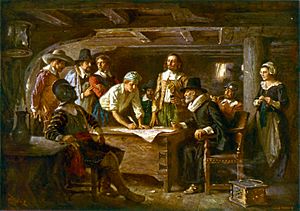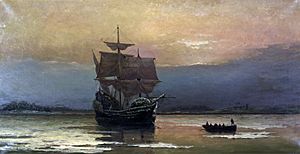Stephen Hopkins (Mayflower passenger) facts for kids
Stephen Hopkins (born around 1579 – died between June and July 1644) was an important passenger on the famous ship Mayflower in 1620. He was one of 41 people who signed the Mayflower Compact, an important agreement for the new colony. Stephen also helped govern Plymouth Colony until 1636. He worked as a tanner (someone who makes leather) and a merchant. He was chosen by a company in London to help lead the new colony. Stephen was the only Mayflower passenger who had already visited the New World. He had been shipwrecked in Bermuda in 1609 and lived in Jamestown, Virginia until 1614 before returning to England.
Contents
Stephen Hopkins' Early Life in England
Stephen Hopkins was baptized on April 30, 1581, in Upper Clatford, England. His parents were John Hopkins and Elizabeth Williams. He later died in Plymouth Colony, Massachusetts, sometime between June 6 and July 17, 1644.
We don't know much about his very early life in Hampshire. His family likely moved to Winchester, Hampshire, by 1586. After his father passed away, Stephen moved to Hursley, Hampshire, by 1604.
Stephen's Adventures in the New World
Many experts believe that Stephen Hopkins was the only Mayflower passenger who had already been to the New World. He had some amazing adventures, including surviving a shipwreck in Bermuda (sometimes called the "Isle of Devils") and working in Jamestown from 1610 to 1614.
In 1609, Stephen Hopkins started working as a clerk, reading religious texts to a group of people, some of whom were part of the Virginia Company. On June 2, 1609, Stephen left his family and sailed for Jamestown on a ship called the Sea Venture. This ship was carrying the new governor for Jamestown, Sir Thomas Gates, along with supplies and new settlers.
About two months into their journey, a huge storm hit on July 24, 1609. The storm lasted for five days. Just as the Sea Venture was about to sink, they saw land – the island of Bermuda! The ship had to be run aground about a mile offshore to keep it from sinking completely. The people who survived the shipwreck soon found that Bermuda was a beautiful place with plenty of water and food.
Many of the colonists didn't want to continue the trip to Jamestown. They tried to find ways to stay on the island. Stephen Hopkins argued that the storm had ended their work agreements with the Virginia Company. He believed they were now free to choose if they wanted to follow Governor Gates or start their own settlement. Governor Gates saw this as a challenge to his authority and arrested Stephen Hopkins. He was found guilty, and the punishment was death. However, many people asked for mercy, and Stephen was pardoned. After that, he stopped speaking out against the governor.
On May 10, 1610, two new boats built on Bermuda carried everyone to Jamestown. They arrived eleven days later. What they found in Jamestown was terrible: the colonists were starving. They were afraid to leave their fort and were even tearing down their houses for firewood. They weren't planting crops or trading with the native people, which led to a lot of fighting. When Governor Gates arrived, he saw there was only a few days' worth of food left. He decided to sail to Newfoundland and then find a ship back to England. But just as they were about to leave, an English ship arrived with supplies and a new governor, Lord de la Warr. The colonists were told to go back and rebuild their fort.
Stephen's Return to England
News of the Sea Venture shipwreck reached England. Many scholars think that William Shakespeare used this story as inspiration for his play The Tempest, which was first performed in November 1611. The play shows a group of passengers shipwrecked by a storm. There's a funny character named Stephano who tries to take over as leader on the island. It's possible that this character was based on Stephen Hopkins.
While Stephen was away, his wife Mary managed to survive by running a shop and receiving some of his wages. Sadly, she died unexpectedly in May 1613, leaving their three young children alone. By 1614, a letter reached "Hopkins" in Jamestown, likely telling him about his wife's death. He soon returned to England to care for his children.
He then moved to London and married his second wife, Elizabeth Fisher. Even after all the difficulties he faced in the New World – the shipwreck, being sentenced to death, and years of hard work in Jamestown – Stephen decided to go back to America with his family on the Mayflower voyage.
The Mayflower Journey

Stephen Hopkins, his wife Elizabeth, and his children Constance, Giles, and Damaris, along with two servants (Edward Doty and Edward Leister), left Plymouth, England, on the Mayflower on September 6, 1620. The ship was about 100 feet long and carried 102 passengers and 30-40 crew members in very crowded conditions.
After about two months, strong storms hit the ship. The wood of the ship shook badly, and water leaked in, making everyone wet and sick. This, along with not enough food and dirty conditions, caused many people to get sick and die, especially women and children. Two people died during the journey, but the worst was yet to come. After they arrived, almost half the passengers died during the cold, harsh winter in New England.
On November 9, 1620, after about three months at sea, they finally saw land. It was the Cape Cod Hook, now called Provincetown Harbor. They tried to sail south to their planned destination in Colony of Virginia, but strong winter seas forced them back to Cape Cod. They anchored there on November 11. That same day, the Mayflower Compact was signed. Just like the passengers on the Sea Venture, the Mayflower passengers argued that they were free from their agreements with the Virginia Company and could now choose their own leaders. Stephen Hopkins was one of the people who signed this important document.
Life in Plymouth Colony
Stephen Hopkins was part of the first groups that explored the Cape Cod area while the Mayflower was anchored. He knew a lot about hunting and the ways of the Native Americans from his years in Jamestown. This knowledge was very helpful to the Pilgrim leaders.
The first official meeting with the native people happened at Stephen Hopkins' house. He also helped with early visits between the Pilgrims and their leader, Massasoit. Over the years, Stephen's knowledge of local languages was very useful to Pilgrim leaders like Myles Standish and Edward Winslow.
Stephen Hopkins' Tavern
Stephen Hopkins ran a tavern, or "ordinary," in Plymouth from the early days of the colony until he died in 1644. An "ordinary" in the 1600s was a tavern that offered set mealtimes and prices.
Stephen had some issues with the local Court because of his tavern. Records show he was fined for letting people drink in his house on Sundays and for allowing servants and others to drink there against Court rules. He was also fined for selling drinks and other items at very high prices.
Stephen Hopkins' Family Life
Stephen Hopkins had two known wives and many children.
- Mary Kent is believed to be Stephen Hopkins' first wife. She was born around 1580 in Ratlake, England. Mary and Stephen had three children together: Elizabeth, Constance, and Giles. Their baptisms were recorded in Hursley, Hampshire. After they married, Mary and Stephen lived with her mother, Joan, and ran a small alehouse. Stephen left for America in 1609, leaving his children with Mary and her mother. Mary died in May 1613, at about 33 years old. Stephen learned of her death in Jamestown and returned to England to care for his children.
- Elizabeth Fisher is believed to be Stephen Hopkins' second wife. They likely married in London in 1617 or 1618. Stephen, Elizabeth, and his children Giles and Constance were all Mayflower passengers. Elizabeth died before Stephen wrote his will in 1644, as he asked to be buried next to her.
Stephen's Children
Here are Stephen Hopkins' children:
- Children with Mary:
* Elizabeth Hopkins: Born in 1603 or 1604. She was alive when her mother died in 1613 but did not come on the Mayflower. She may have married or passed away before the voyage. * Constance Hopkins: Born in 1606. She was a Mayflower passenger. She married Nicholas Snow in Plymouth and had twelve children. She died in 1677 in Eastham. * Giles Hopkins: Born in 1607 or 1608. He was a Mayflower passenger. He married Catherine Wheldon and had ten children. He died in Eastham between 1688 and 1690.
- Children with Elizabeth:
* Damaris (1): Born around 1618 in England. She was a Mayflower passenger but died young in Plymouth. * Oceanus: Born at sea during the Mayflower voyage in 1620. He died by 1627. * Caleb: Born around 1624 in Plymouth. He became a sailor and died in Barbados between 1644 and 1651. * Deborah: Born around 1626 in Plymouth. She married Andrew Ring and had six children. * Damaris (2): Born around 1627-1628 in Plymouth. She married Jacob Cooke and had seven children. * Ruth: Born around 1630 in Plymouth. She died between 1644 and 1651 and was not married. * Elizabeth: Born around 1632 in Plymouth. She likely died before 1659 and was not married.
Stephen Hopkins' Death
Stephen Hopkins died sometime between June 6 and July 17, 1644. He wrote his will on June 6, 1644, asking to be buried next to his wife, Elizabeth, who had already passed away. His will mentioned his sons Giles and Caleb, and his daughters Constance, Deborah, Damaris, Ruth, and Elizabeth. The exact place where Stephen Hopkins was buried is not known.
Servants on the Mayflower with the Hopkins Family
- Edward Doty: He was a servant, likely in his early twenties. He signed the Mayflower Compact. Edward had a long and sometimes difficult life in Plymouth Colony, dying around 1655.
- Edward Leister: He also came on the Mayflower as a servant to Stephen Hopkins. He signed the Mayflower Compact. He may have been in his early twenties. William Bradford, a Pilgrim leader, reported that Edward Leister "went to Virginia, and ther dyed," but no records of him in Virginia have been found.
See also
- First Families of Virginia
- Jamestown, Virginia
- Pilgrim Fathers
- Stephano (The Tempest)


